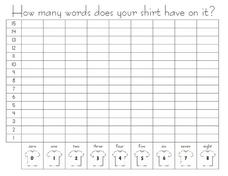Curated OER
The Number 6
In this math worksheet, students learn to count sets of six by examining 8 sets of puppy pictures. Students color only those sets which show six.
Curated OER
Number Tracing And Counting
In this math worksheet, students learn to count sets from 1 to 10 by tracing the number shown and counting out that amount of pictures. Students color the insects to correspond with the number shown.
Curated OER
How Many Pockets Do You Have Today?--class Bar Graph
In this math learning exercise, students complete a class bar graph. Students survey classmates as to how many pockets they have today and plot the data on the graph.
Curated OER
How Many Word Does Your Shirt Have on It? --class Bar Graph
In this math worksheet, students participate in a group bar graph activity. Students survey classmates about how many words, if any, are on their shirts. Results are plotted on a bar graph.
Curated OER
Connect the Dots, Then Color -- Handwashing
In this health worksheet, students explore the importance of handwashing by connecting the dots on a picture and coloring it.
Curated OER
Multiples of Three Chickens
In this math worksheet, students find the multiples of threes and count them while coloring of the chickens. They could also be used as cutouts.
Curated OER
Number 5
In this literacy worksheet, students color in the numbers while counting to five. The objects can be cutout and a number should be assigned to each.
Curated OER
Four Bears
In this counting worksheet, students color a picture of four bears. They then trace over the number 4, and practice printing the number.
Curated OER
Chicks Number Line
In this elementary math worksheet, 3rd graders find the values up to the number ten on the number line. It can be used for number recognition and counting as well.
Curated OER
Fall Numbers
For this elementary math worksheet, 1st graders practice cutting out the numbers and put them into different orders in order to practice counting.
Curated OER
Numberbook
In this elementary math worksheet, students practice writing the number in numeral and word form. They perform this skill for each number from one to ten and each number is done on a page.
Curated OER
Counting Factors to 15
In this basic math worksheet, 5th graders practice counting the factors for each numeral from one to fifteen. The skill of counting is also developed as a basis for factoring.
Curated OER
Wooden Toys
Students are asked what kinds of toys do they think people made a long time ago? They are shown pictures of some toy wooden soldiers that were made a long time ago. Students count the number of toy sailors in red jackets. They write the...
Curated OER
Counting Book
Students brainstorm theme for counting book, work in pairs to create book using Kid Pix that shows numbers one through ten, make correct number of pictures or stamps to correspond to numerals on pages, and print out pages to be bound...
Curated OER
Zero Is Our Hero
Students engage in a lesson that is concerned with the mastery of counting by ten's. They practice counting to varying quantities not to exceed 100. Students could also use manipulatives that are separated into groups of ten.
Curated OER
Using Tens Frames for One to One Counting
Students complete a variety of exploratory exercises regarding counting through 10. They recognize the numbers 0-10 as represented using the quinary pattern on the tens frames. They are able to visualize the patterns for future...
Curated OER
100 More 100 Less
Third graders review the concept of place value and number sense. With a partner, they are given four cards with numbers on them. Using the cards, they practice making new numbers and completing addition and subtraction to find the...
Curated OER
Candy Land Math
Students order numbers and sets of objects from 0 through 10 and organize and interpret information collected from the immediate environment. They read and interpret graphs usin real objects and the computer. Finally, students sort a...
Curated OER
Classroom Census
Students take a classroom census. They count in sets, sortan classify groups and ascertain the value of counting.
Curated OER
Counting
Students practice counting out a predetermined number of items during their snack or other activities. While counting the item out, they must say the number and place them on a template until they reach the correct amount. They are given...
Curated OER
Smart Doubling
Second graders use mental math in calculations involving addition and subtraction. They study doubles facts to work out addition problems mentally using part and or whole reasoning.
Curated OER
Lu-Lu
First graders practice their counting skills while playing a Hawaiian game called Lu-Lu. Lu-Lu is a Hawaiian counting game. It is played with four stones. Each stone is divided into four equal sections and dots are placed in the...
Curated OER
Spiders Are Fun
Students study facts about spiders using a number of literary forms, including stories, poems, and songs. They work with consonant sounds by matching pictures with the beginning consonant sounds. They design art projects that emphasize...
Curated OER
Counting Money
Students discover the importance of economics through Shel Silverstein's poem Smart. Students are introduced to the concept of earning money and using money to purchase necessary items, after becoming familiar with U.S. money.

























